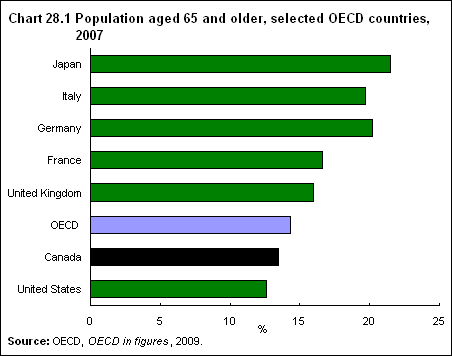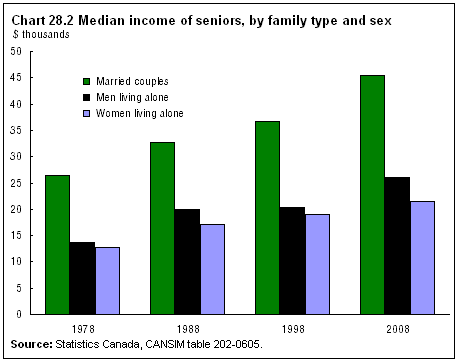Seniors
Archived Content
Information identified as archived is provided for reference, research or recordkeeping purposes. It is not subject to the Government of Canada Web Standards and has not been altered or updated since it was archived. Please "contact us" to request a format other than those available.
Related information
Canada's population is aging, yet it has one of the lowest proportions of seniors among the Organisation for Economic Co-operation and Development (OECD) countries. As of July 1, 2009, there were 4.7 million seniors aged 65 and older in the country, accounting for a record high of 13.9% of the population.
In 2007, when 13.5% of Canadians were seniors, the proportion was lower than in the United Kingdom (16.0%), France (16.6%) and Germany (20.2%). The United States, however, has an even lower proportion of seniors than Canada in its population (12.8%).
As baby boomers enter this age group over the coming decades, the proportion of seniors will increase rapidly. According to the medium-growth scenario of the most recent projections, seniors could account for close to 25% of the population by the end of the 2030s.
Life expectancy at age 65 has also been increasing. In 1985, a 65-year-old could expect to live another 17 years. That had increased to 20 years by 2006: 18 years for men and 21 years for women.
As of July 1, 2009, there were 1.3 million people aged 80 and older in Canada, representing nearly 4% of the population, and there were 6,000 Canadians aged 100 and older. In 2001, centenarians numbered 3,400. The number of centenarians could reach more than 17,000 people at the beginning of the 2030s.
Where seniors live
At just over 15% in Prince Edward Island and nearly 16% in both New Brunswick and Nova Scotia, the Maritime provinces had the largest proportions of seniors aged 65 and older as of July 1, 2009. At almost 14%, Ontario and Manitoba had the second- and third-smallest proportions of seniors, while Alberta was the province with the smallest proportion at 10%.

View data source for chart 28.1
Seniors' financial status
More seniors are continuing to work. Their employment rate was about 10% in 2009, which marked an increase from almost 6% employment in 1999. Among the provinces in 2009, Alberta experienced the highest employment rate for seniors, at nearly 16% of seniors.
The median after-tax income of elderly married couples (in 2008 constant dollars) rose from $32,400 in 1982 to $45,500 in 2008, an increase of 40%. It ranged from $34,200 in Newfoundland and Labrador to $52,100 in British Columbia. The median after-tax incomes of unattached senior men and women rose by 53% and 41% respectively over this period.
Education matters for seniors when it comes to income. Among those with a high school diploma or less, 13% lived in low income at some point from 2002 to 2007. This compares with 5% of seniors with a university degree. The incidence of low income among seniors with lower education is significantly less than among their non-senior counterparts, partly owing to income-security programs for seniors, such as Old Age Security and the Guaranteed Income Supplement.
Since the early 1980s, as the country's public pension plans have matured, fewer seniors have been living in low income. In 2008, senior families were the family type with the lowest incidence of low income, with 1.6% of seniors living in families experiencing low income compared with 14.6% of seniors living on their own.
- Date modified:

